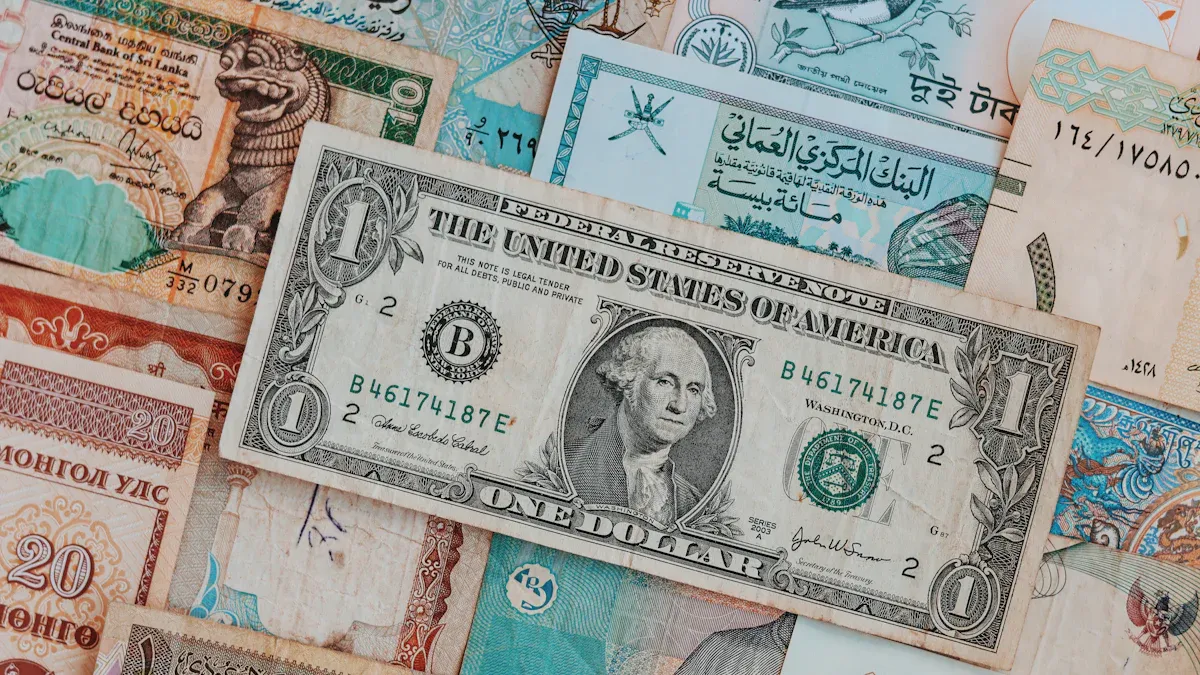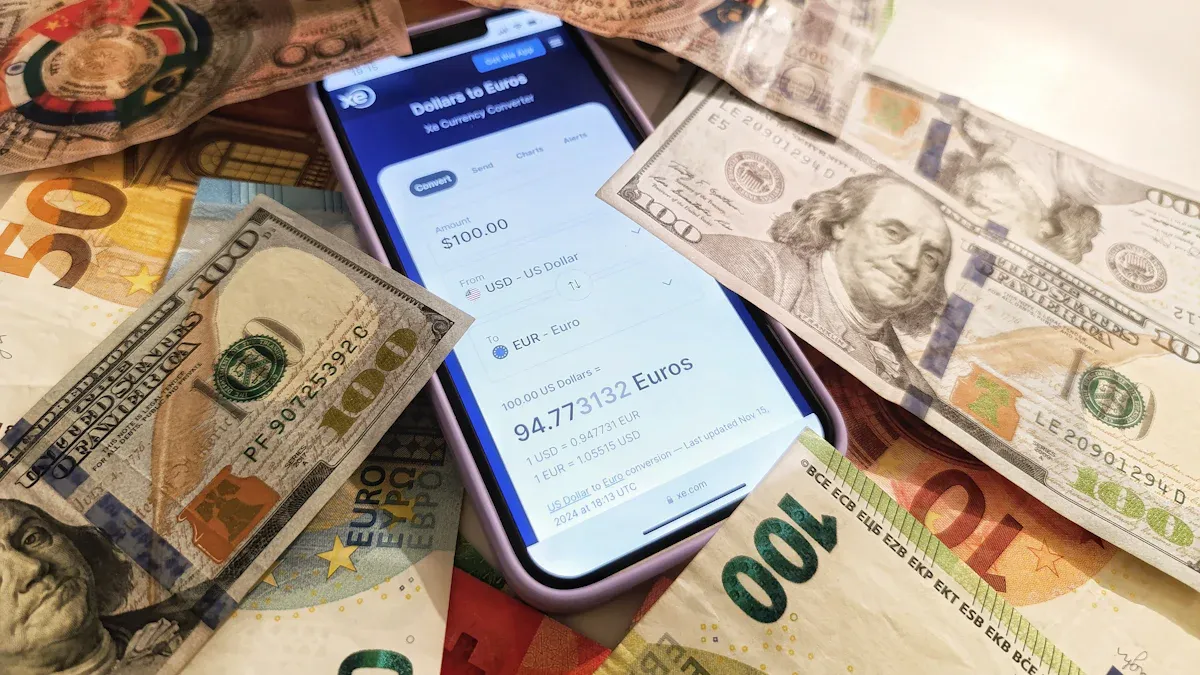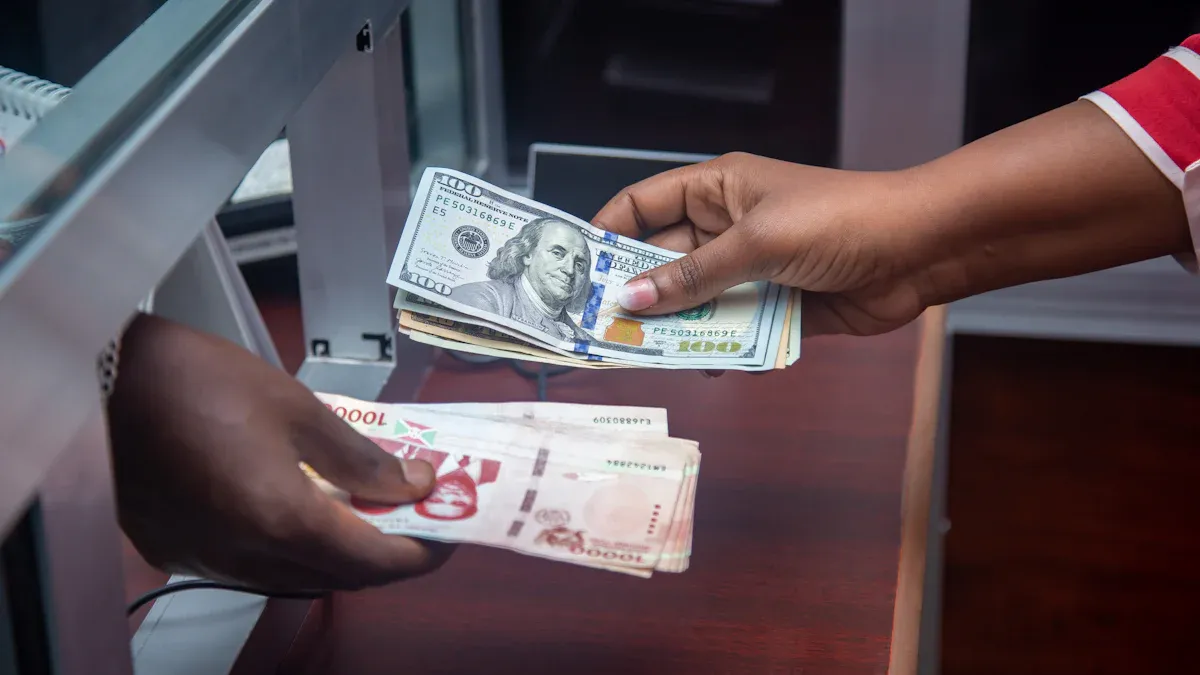- EasyCard
- Trade
- Help
- Announcement
- Academy
- SWIFT Code
- Iban Number
- Referral
- Customer Service
- Blog
- Creator
How to Convert $400 into Ghanaian Cedis? Analysis of the Best Exchange Rate and Conversion Methods

Image Source: pexels
Planning to convert 400 USD to Ghanaian Cedis? Based on the latest exchange rates, 400 USD can be converted to approximately 5,040 Ghanaian Cedis (GHS).
However, please note that this figure is not fixed. The exchange rate market is constantly fluctuating. For example, in the past 90 days, the exchange rate for 1 USD has ranged between a high of 12.6 GHS and a low of 10.45 GHS.
The core purpose of this article is to teach you how to take control. You will learn how to check real-time exchange rates yourself and find the most cost-effective and secure conversion methods to ensure every cent is well spent.
Key Takeaways
- 400 USD can be converted to approximately 5,040 Ghanaian Cedis, but exchange rates are subject to change.
- Online remittance services typically offer the best exchange rates and transparent fees, making them the top choice for converting USD.
- Banks and airport exchange counters generally offer less favorable rates, while authorized forex bureaus are a good option for cash conversions.
- Before converting, compare total costs, including exchange rates and all fees, and prepare identification documents.
- After conversion, carefully verify the receipt and keep it safe in case of issues.
Exchange Rate Basics: How to Calculate Conversion Amounts
Before converting currency, understanding how exchange rates work is crucial. This knowledge helps you accurately estimate the final amount you’ll receive and avoid unnecessary losses due to information gaps.
Key Concepts of Exchange Rates
You may have seen an “official” exchange rate when searching online, which typically refers to the mid-market exchange rate. You can think of it as the midpoint between the buy and sell prices, representing the fairest market value of a currency, without any service provider’s profit margin.
However, when you actually convert currency, you’ll encounter two different prices:
- Bank Buying Rate: When you exchange USD for Cedis, the bank is “buying” your USD. They will use this lower rate.
- Bank Selling Rate: If you need to exchange Cedis back to USD, the bank is “selling” USD and will use this higher rate.
Key Point: The difference between the buying and selling rates is called the “spread”. This is how banks and forex services make their profits. As a result, the amount you ultimately receive will always be slightly less than what you’d calculate using the mid-market rate.
Recommended Tools for Real-Time Exchange Rate Checks
To obtain the most accurate reference exchange rates, you need to use authoritative online tools. These platforms typically display real-time mid-market rates, giving you a clear understanding of current market conditions.
- Wise (formerly TransferWise): Offers a real-time updated currency converter and allows you to view historical exchange rate charts for up to 5 years. It prides itself on transparency and using the mid-market rate.
- XE.com: Another widely popular exchange rate lookup website, offering interactive historical charts for up to 10 years, helping you analyze rate trends.
- Exchange-Rates.org: A reliable data source with over 15 years of history, providing accurate current and historical exchange rate information.
Using these tools is simple: just select the base currency (USD) and target currency (GHS) to instantly see the latest rate data.
Calculating the Actual Amount for 400 USD
Now, let’s use a specific example to see how different exchange rates affect the final amount you receive. Suppose you want to convert 400 USD to Ghanaian Cedis; we’ll compare the ideal scenario with the real-world outcome.
| Rate Type | Exchange Rate (USD:GHS) | Calculation | Final Amount Received (GHS) |
|---|---|---|---|
| Mid-Market Rate | 1 : 12.60 | 400 * 12.60 | 5,040 |
| Actual Conversion Rate | 1 : 12.25 | 400 * 12.25 | 4,900 |
| Difference | -140 |
From the table, you can clearly see that even a small rate difference can result in receiving 140 Cedis less. This doesn’t even account for potential fixed transaction fees. Therefore, comparing the “actual conversion rate” offered by different channels is critical.
Converting 400 USD to Ghanaian Cedis: Best Channels Compared

Image Source: pexels
Having understood how to calculate exchange rates, the next step is choosing the right conversion channel. This choice directly determines how many Cedis you’ll ultimately receive. Below, we compare several mainstream conversion methods in detail to help you make the most informed decision.
Online Remittance Services
For non-cash transactions, online remittance services are typically your best choice. Platforms like Wise, Remitly, and Xe have disrupted traditional currency exchange, offering better rates and higher transparency.
Core Advantages:
- Better Rates: They often use or are very close to the “mid-market rate” we mentioned, with minimal spreads.
- Transparent Fees: You can see all fees upfront before transferring, with no hidden charges.
- Fast Speed: Many transfers can be completed in a short time.
Transfer Speed Reference
- Wise: Funds typically arrive within minutes to four business days, with most transfers completing in minutes.
- Remitly: Standard services usually take two to three days, but expedited options are available for an additional fee.
When planning to convert 400 USD to Ghanaian Cedis, these platforms typically offer the most competitive rates.
| Feature | Advantage | Potential Limitations |
|---|---|---|
| Exchange Rate | Very close to mid-market rate, small spread | Rates fluctuate in real time, requiring transaction locking |
| Fees | Typically a small fixed fee + percentage fee, fully transparent | May not be cost-effective for very large or very small amounts |
| Requirements | Requires account registration, recipient needs a bank account or mobile wallet | Not suitable for scenarios requiring immediate physical cash |
Local Bank Conversion
Converting currency through a bank is the most traditional and seemingly secure method. You can visit a commercial bank counter in Ghana to handle the transaction.
The main advantage of this method is its safety and reliability. However, its exchange rates are typically not the best. Banks need to cover operational costs and market risks, so they add a significant markup to the benchmark rate published by the Bank of Ghana (BoG). Some commercial banks and forex bureaus may apply markups as high as 7%. Even internationally licensed banks in Hong Kong include such spreads in their retail forex services.
Key Reminder: Banks are a secure choice but not the most cost-effective. You trade lower rates for safety, meaning you receive fewer Cedis.
Authorized Forex Bureaus
If you’re carrying USD cash and want to exchange it locally in Ghana, authorized forex bureaus (Licensed Forex Bureaus) are a highly convenient option. They are widely available in commercial districts and airports in major cities like Accra.
These bureaus typically offer more competitive rates than banks due to fiercer competition. However, their rates are still higher than the official mid-market rate.
Flexible Operating Hours:
- Branches in urban areas (e.g., Osu) are typically open during regular business hours from Monday to Saturday (e.g., 8 AM to 6 PM).
- Airport branches are even more convenient, with many forex bureaus offering extended hours, such as 6 AM to 10 PM, and some at Terminal 3 providing 24/7 service.
Pro Tip: How to Identify Legitimate Forex Bureaus?
- Look for an official license issued by the Bank of Ghana displayed prominently.
- Ensure they provide a formal printed receipt clearly listing the exchange rate and total amount.
- Avoid street transactions with individuals, even if they claim to be from a bureau.
Conversion Traps to Avoid
To safely convert 400 USD to Ghanaian Cedis, you must steer clear of the following high-risk channels to avoid financial losses.
- Airport Exchange Counters: While convenient, airport exchange counters typically offer the worst rates among all channels. They capitalize on travelers’ immediate needs with high profit margins. Unless it’s an emergency, avoid exchanging here.
- Black Market Transactions: You may encounter individuals on the street offering tempting rates to exchange currency. These transactions are extremely risky, and you could receive counterfeit money or face robbery during the process.
- Common Scams: The Bank of Ghana has issued warnings to the public about various financial scams.
- Hard Currency Exchange Scams: Scammers may use various pretexts for illegal exchanges.
- Impersonation: Beware of those posing as “foreign investors” or “Bank of Ghana clearing agents” promising high returns.
Remember, any rate that seems “too good to be true” is almost certainly a trap. Always choose official and reputable channels for conversion.
Safe Conversion: Detailed Steps and Practical Tips

Image Source: pexels
Having understood the pros and cons of different channels, you also need to know the specific steps to follow. Adhering to these three key steps ensures your conversions are safe, efficient, and cost-effective.
Before Conversion: Compare Total Costs
The best conversion isn’t just about finding the highest rate; you must focus on the “total cost.” Some providers may offer attractive rates but compensate with hidden fees.
Core Formula: Amount received = (Conversion amount × Actual exchange rate) - All fees
When comparing, clarify what fees are included. Common fee types include:
- Service Fee: A fixed transaction processing fee.
- Commission Fee: A percentage-based fee on the converted amount.
The smart approach is to use online tools like Wise or WorldRemit. They display the exact amount the recipient will receive when converting 400 USD to Ghanaian Cedis, with all costs calculated upfront. Before deciding, compare the provider’s rate with the mid-market rate on Google to quickly identify bad deals.
During Conversion: Prepare Required Documents
When visiting a bank or authorized forex bureau for cash conversion, you need to prepare the necessary documents. This is both a regulatory requirement and a measure to ensure transaction safety.
Typically, you need to provide:
- Valid Identification: Your passport is the best internationally accepted option.
- Transaction Form: Many institutions require you to fill out a foreign exchange transaction form, such as the one used by GCB Bank. You’ll need to provide personal details and conversion specifics.
Preparing these documents in advance can make the conversion process smoother and faster.
After Conversion: Verify and Retain
After completing the transaction, don’t leave the counter immediately. Taking a minute to verify the receipt is crucial.
Ensure the receipt clearly lists:
- The USD amount you paid (400 USD)
- The exchange rate used
- Any deducted fees (if applicable)
- The total Ghanaian Cedis received
After verifying, keep the receipt safe. It serves as your transaction proof and is vital for resolving any issues. Recording the conversion location and time is also a good habit.
To convert 400 USD to Ghanaian Cedis, your best strategy is to use online remittance platforms. Services like Wise typically offer better rates, allowing you to receive more Cedis. For cash conversions, authorized forex bureaus in urban areas are the next best option.
Clear Call to Action: Before converting, take a few minutes to compare the “rate + fees” total cost across at least 2-3 channels using the tools mentioned.
Remember, financial markets are ever-changing. Building a habit of checking and comparing rates in real time is key to long-term cost savings in exchange rate fluctuations.
FAQ
Are There Fees for Converting 400 USD?
Yes, most channels charge fees. Online platforms typically charge transparent service fees, while banks and exchange bureaus hide fees in the exchange rate spread. Compare the “rate + fees” total cost to find the most cost-effective option.
Should I Convert All 400 USD at Once?
It depends on your needs. If you’re unsure how much cash you need, consider converting a portion first. Cedi rates fluctuate, and splitting conversions can spread risk. However, each conversion may incur fixed fees, so weigh the pros and cons.
Can I Use USD Directly for Spending in Ghana?
In large hotels, airlines, or select tourist shops, you may be able to pay with USD. However, in most daily scenarios, such as local markets, restaurants, and transportation, you must use Ghanaian Cedis.
Is Receiving Transfers via Mobile Money Convenient?
Very convenient. Mobile money is extremely popular in Ghana and an excellent way to receive online transfers.
- Funds arrive quickly, often instantly.
- Recipients can use the money directly from their phone or withdraw cash at agent locations.
*This article is provided for general information purposes and does not constitute legal, tax or other professional advice from BiyaPay or its subsidiaries and its affiliates, and it is not intended as a substitute for obtaining advice from a financial advisor or any other professional.
We make no representations, warranties or warranties, express or implied, as to the accuracy, completeness or timeliness of the contents of this publication.




Contact Us
Company and Team
BiyaPay Products
Customer Services
is a broker-dealer registered with the U.S. Securities and Exchange Commission (SEC) (No.: 802-127417), member of the Financial Industry Regulatory Authority (FINRA) (CRD: 325027), member of the Securities Investor Protection Corporation (SIPC), and regulated by FINRA and SEC.
registered with the US Financial Crimes Enforcement Network (FinCEN), as a Money Services Business (MSB), registration number: 31000218637349, and regulated by FinCEN.
registered as Financial Service Provider (FSP number: FSP1007221) in New Zealand, and is a member of the Financial Dispute Resolution Scheme, a New Zealand independent dispute resolution service provider.




















